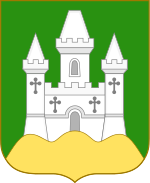Amsberg
This article has multiple issues.Please helpimprove itor discuss these issues on thetalk page.(Learn how and when to remove these template messages)
|
| House of Amsberg | |
|---|---|
 Coat of arms of the Amsberg family | |
| Current region | |
| Place of origin | |
| Founded | 1686 |
| Founder | Jürgen Amtsberg |
| Current head | Willem-Alexander of the Netherlands |
| Titles |
|
| Cadet branches | |
TheHouse of Amsberg(German:von Amsberg,Dutch:van Amsberg) is aGerman noble familythat originated inMecklenburgand whoseagnatichead is the presentKing of the Netherlands,Willem-Alexander.A great-grandson of a blacksmith and grandson of a baker, parish pastor August Amsberg (1747–1820) started calling himself "vonAmsberg "in 1795, and the family's right to use this name was confirmed in 1891 byFrederick Francis III, Grand Duke of Mecklenburg-Schwerin.By this permission to use anobiliary particle,the family effectively became part of the untitledlower nobilityof theGrand Duchy of Mecklenburg-Schwerin.
Members of the family live in the Netherlands and in Northern Germany. Its most notable member is the family's current head (i.e. senior male-line descendant), KingWillem-Alexander of the Netherlands.King Willem-Alexander, his brothers and his brothers' children hold the title of "Jonkheer(or female Jonkvrouw) van Amsberg "and have thesurname"van Oranje-Nassau van Amsberg".
History[edit]
The family line traces back to one Jürgen Amtsberg (d. 1686), masterblacksmithin the village of Schwichtenberg nearBorrentin,then part ofSwedish Pomerania.His great-grandson Johann David TheodorAugustAmsberg (1747–1820),Protestantpastor at the parish church ofKavelstorfnearRostockin theDuchy of Mecklenburg-Schwerin,from about 1795 styled himselfvonAmsbergwithout objection. The Amsbergs had been commoners at first, and the preposition probably was used to signify the family from the name of their ancestors, rather than from the name of a place they originated from. A notable member was his son Philipp August von Amsberg (1788–1871), who initiated the establishment of theDuchy of Brunswick State Railwaythat was inaugurated in 1838. The family received official approval to use thenobiliary particleby decree of theGrand Duchy of Mecklenburg-Schwerinin 1891.
On 10 March 1966,Claus von Amsbergmarried theheir presumptiveto theDutchthrone, Princess Beatrix of Orange-Nassau, Princess ofLippe-Biesterfeld.From 1980 until his death in 2002, he was prince consort of theQueen of the Netherlands.He is the father ofWillem-Alexander,King of the Netherlands andJonkheervan Amsberg. Willem-Alexander's younger brother PrinceFriso van Oranje-Nassau van Amsberg,due to his marriage withMabel Martine Wisse Smit,lost his status as a Prince of the Netherlands but retained for himself royal status as prince of Orange-Nassau and for his children received the title of count/countess of Orange-Nassau.
The marriage of the third-born son, PrinceConstantijn,so far has produced the only male heir of the main Amsberg line,Claus-Casimir van Oranje-Nassau van Amsberg,who was born in 2004. In 2001, it was established by Decree that children born in the marriage of Prince Constantijn will hold the hereditary noble title and honorific of Count (Countess) van Oranje-Nassau, Jonkheer (Jonkvrouw) van Amsberg and have the surname Van Oranje-Nassau van Amsberg. In 2004, the same regulation was established for Prince Friso and the children born in his marriage. When Willem-Alexander became king in 2013, the House of Amsberg did not become the ruling house of the Netherlands, which stayed as the house of his mother, as is tradition in the Netherlands.
Several members of the family, mainly descendants of Philipp August von Amsberg and of Prince Claus' great-uncleJoachim von Amsberg(1869–1945), still live inNorthern Germany.
The Dutch branch of the family, i.e. Prince Claus and his descendants, has some distant Dutch/Flemish ancestors who left theLow Countriesduring Spanish rule, such as theBerenberg familyand other prominent families ofAntwerp.
Other notable family members include ColonelJoachim von Amsberg,GeneralJoachim von Amsbergand bankerJoachim von Amsberg.
Heads of the family[edit]
This is a list of the heads, i.e. the senior male-line members, of the Amsberg family, as well the patrilineal line of the current Dutch royal family. Before the 1891 ennoblement, being the senior male descendant did not have any legal relevance, and as such the term "head" is anachronistic before the family's rise as a noble and eventually royal family. The headship of the family since its recognition as noble in 1891 has some historical legal relevance prior to the formal abolition of the nobility's privileges in 1918.
- Jürgen Amtsberg, ca. 1640–1686, blacksmith
- Jürgen Amtsberg, 1680–1756, baker
- Georg Amtsberg, 1717–1772
- Johann David Theodor August Amsberg, clergyman. He started calling himself "von Amsberg" from 1795, 1747–1820, pastor inKavelstorf
- Joachim Karl Theodor von Amsberg, 1777–1842
- Gabriel Ludwig Johann von Amsberg, 1822–1899, received permission from the Grand Duke to use the particle "von"in 1891, effectively an ennoblement
- Wilhelm von Amsberg, 1856–1929
- Claus Felix von Amsberg,1890–1953
- Prince Claus of the Netherlands,Jonkheer van Amsberg, né Klaus von Amsberg, 1926–2002, a former diplomat of Germany
- King Willem-Alexander of the Netherlands,Jonkheer van Amsberg, b. 1967.
Line of succession to the headship of the Amsberg family[edit]
Since German aristocracy practice agnatic primogeniture, theheir presumptiveto the headship, and the ones next in line, are
- Prince Constantijn of the Netherlands,Jonkheer van Amsberg,the King of The Netherlands'younger brother
- Count Claus-Casimir of Orange-Nassau, Jonkheer van Amsberg,Constantijn's son
- Dirk von Amsberg(b. 1961), a grandson ofGeneralJoachim von Amsberg,who in turn was a son of Gabriel Ludwig Johann von Amsberg
- Paul von Amsberg(b. 2002), Dirk's son
Literature[edit]
- Genealogisches Handbuch des Adels,AdelslexikonBand I, Band 53 der Gesamtreihe,C. A. Starke Verlag,Limburg (Lahn) 1972,ISSN0435-2408
- Die Ahnen Claus Georg von Amsberg (Euler) - Nassau und die Niederlande (Heck),Starke Verlag 1966, Sonderdruck aus Archiv für Sippenforschung Heft 21
